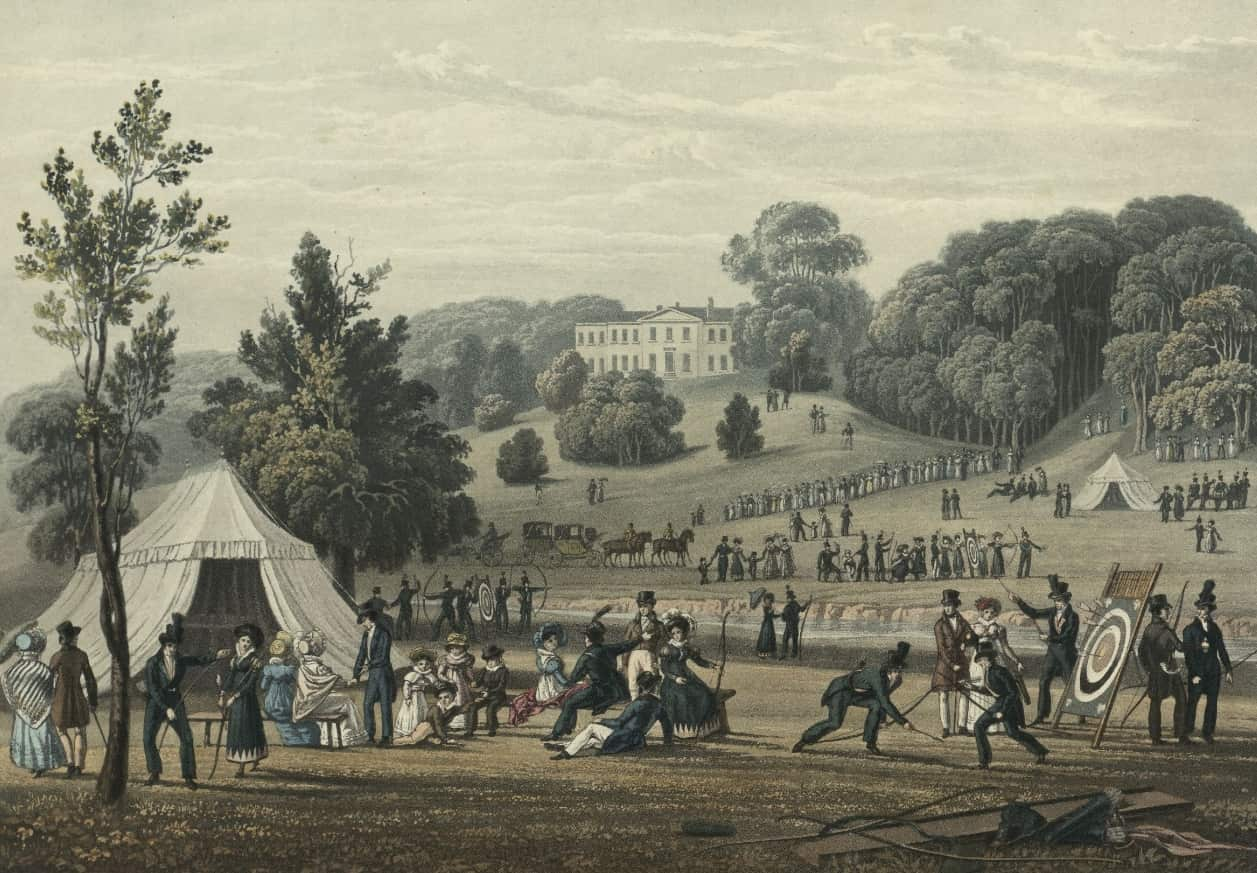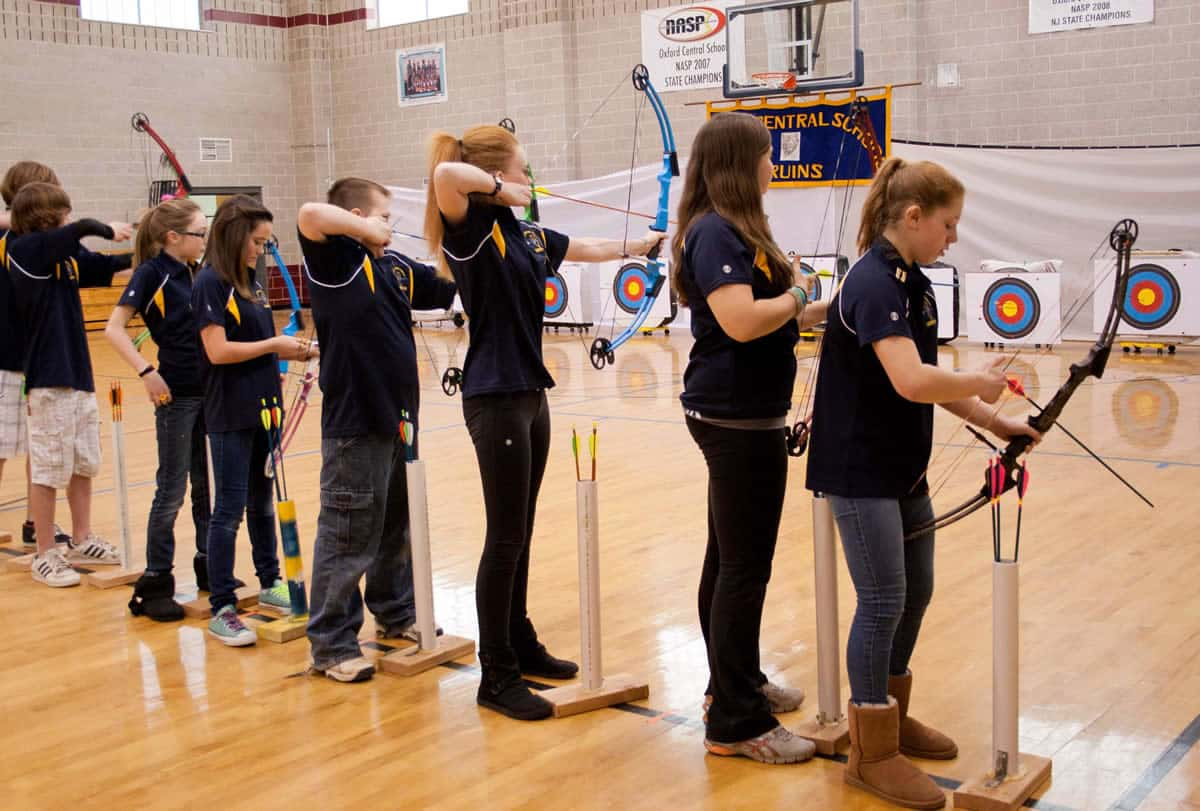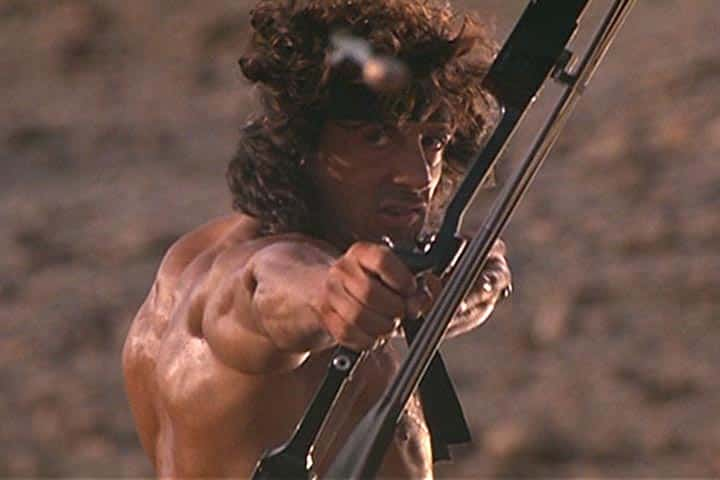Beyond throwing rocks, archery is perhaps the most universal known means of warfare and hunting throughout the world. Dating to over 10,000 years ago and – with the exception of Australasia – practiced virtually everywhere occupied by humankind.
While largely replaced by the firearm at the start of the modern age, the bow and arrow remained an exclusively noble sport in many places until it experienced a renaissance in the 19th century as a sport of elegance and skill for both men and women.
The archery clubs of the Victorian Age defined the activity as a civilized sport where the affluent had custom equipment made to their own requirements, often with costumes honoring Robin Hood.

With the 20th century, and especially the 1920’s, the attitude that everyone should have access to leisure pursuits dominated the west, and most particularly, in the US. The middle class bought what was previously reserved just for the wealthy: radios, automobiles, washing machines; why not a refined sport previously reserved for much of the aristocracy?
Enter one of the most prominent names in the modern world of archery: Hoyt.
Earl Hoyt Sr started producing wooden bows and cedar arrows from within his St. Louis, Missouri workshop in 1931. Though the nation was in the throes of the Depression, the enforced frugality may have actually helped the appeal of well made archery equipment; it is not difficult to see how the appeal of reusable arrows and discrete use helped jump start the modern sport of bow hunting. However, archery was already a prominent sport in Scout programs and even made a brief appearance in four of the first six Summer Olympics.
Hoyt began his mission with draw knives, wooden billets, and rollers to create the best recurve bows available with technology that was little changed in hundreds of years. The fact that Hoyt’s company endured through the Great Depression is as good a testament as any to the quality and appeal his products offered their customers, both then and today.
In many places, such as Ancient Egypt, archery virtually predates the wheel in human history. Unlike the wheel, however, Hoyt saw that archery equipment could always be improved with the latest manufacturing equipment, techniques and materials. Throughout the 1940’s to the 1960’s, Hoyt Archery established a position on the cutting edge of new archery technology.
At the end of World War II, Hoyt Archery began a string of new innovations including reinforced plastics in production bows in 1946; over draw bows and semi anatomic grips in 1948; Deflex reflex designs for modern recurve bows in 1951. In 1953 the first short recurve hunting bow was released as a compact means to go into the field. This later design borrowed heavily from older, horse archer bow designs, albeit with modern materials and modern accessories.
Further developments continued with patents through the 1960’s, as more Americans became interested in archery, specifically for hunting but also for sport shooting – especially for youth participants. In 1969 a patent was issued to Holless Wilbur Allen for a new type of bow: the compound bow.

Archers, or “toxophilites,” could let loose their arrows at unimaginable weights and velocities from a recurve or straight bow. This opened the sport up to shooters who did not have the upper body strength to shoot at targets further afield.
In 1972, after a 48 year absence, archery returned to the Summer Olympics, and Hoyt was there. At Munich, Hoyt bows were utilized to win the gold in both men and women’s archery events. In the 46 years since, more Olympians have won using Hoyt archery equipment than any other. This is not to say the equipment makes the archer, rather the best archers in the world use a Hoyt when it matters most to them. In fact, in the 2012 Summer games in Salt Lake City, UT, every archer who competed, did so using a Hoyt bow.
In 1983 Hoyt was purchased by Jas D. Easton Incorporated. In a move that often means the end of small business attention to detail in the pursuit of bottom line profits, Easton and Hoyt have appeared to blend the best of both organizations to the benefit of company and customers. Under Easton Inc. Hoyt did not get cheaper, but rather larger and more competitive in the making of modern equipment.
The year before the Salt Lake games, Hoyt continued releasing the latest and greatest technological achievement: the Carbon Element. This was the first in what would be an extensive line of carbon based bows that were both light weight, yet stronger than laminate or aluminum bows.
American owned and operated, Hoyt expanded from its unassuming St. Louis workshop to a 150,000 foot manufacturing facility in Salt Lake City where it operates as the world’s premier bowmaker. The primary goal of its employees is to provide the highest level of quality, whether it be hunting in the field or competing on the tournament line. As a mark of that success, Hoyt has expanded outside the world of exclusive competitors and hunters but also mainstream media, bringing the art of archery further into mainstream media consciousness.
Movies expand the public’s awareness of products, often with somewhat exaggerated details. Yet, when it comes to the new age of archery, the movies focus upon the strengths of not only archery in general but also Hoyt bows.

Rambo II in 1985 and Rambo III in 1988 presented audiences with a custom Hoyt Spectrabow. While Spectra was unique to the movie, Hoyt/Easton quickly capitalized on the movie to offer a new model based upon the film version – explosive arrow tips were, sadly, not offered as accessories.
More recently Hoyt’s Buffalo hunting recurve bow was used by the character Hawkeye in the Avengers movie, as well as by Katniss Everdeen in the Hunger Game series – these were versions of the same bow renowned bow hunter Fred Eichler favors as one of his signature bows. The Hoyt Gamemaster II was used by Hawkeye in The Avengers II: Age of Ultron.
While Hoyt’s leadership will not shy out of the limelight blockbuster movies shine upon their products, and the sport in general, it certainly brings in new customers and tomorrow’s enthusiasts.
Hoyt’s business model and sales continue to be devoted to the customer who is prepared to excel in the sport of hunting or target competitions. “No gimmicks,” the website says, just the best they know how to do. And what they know comes with almost a century of experience and premier innovations that have led the archery market.
Trick or – more accurately – impossible shots on the big screen are exciting for movie goers to marvel over, but when the bow hunter or competitive shooter is ready to get serious, they grab a Hoyt.
Article by Outdoorhub.
